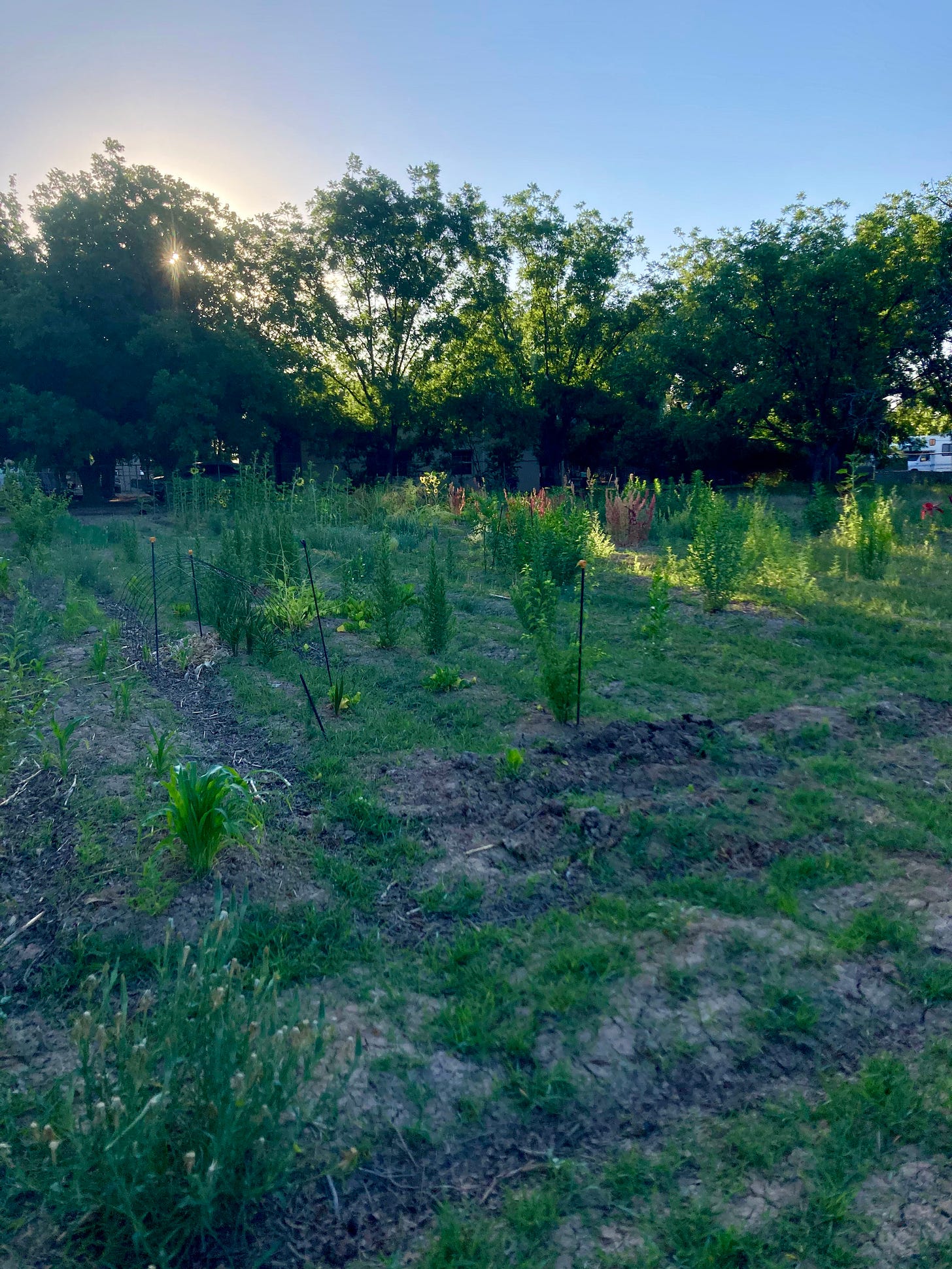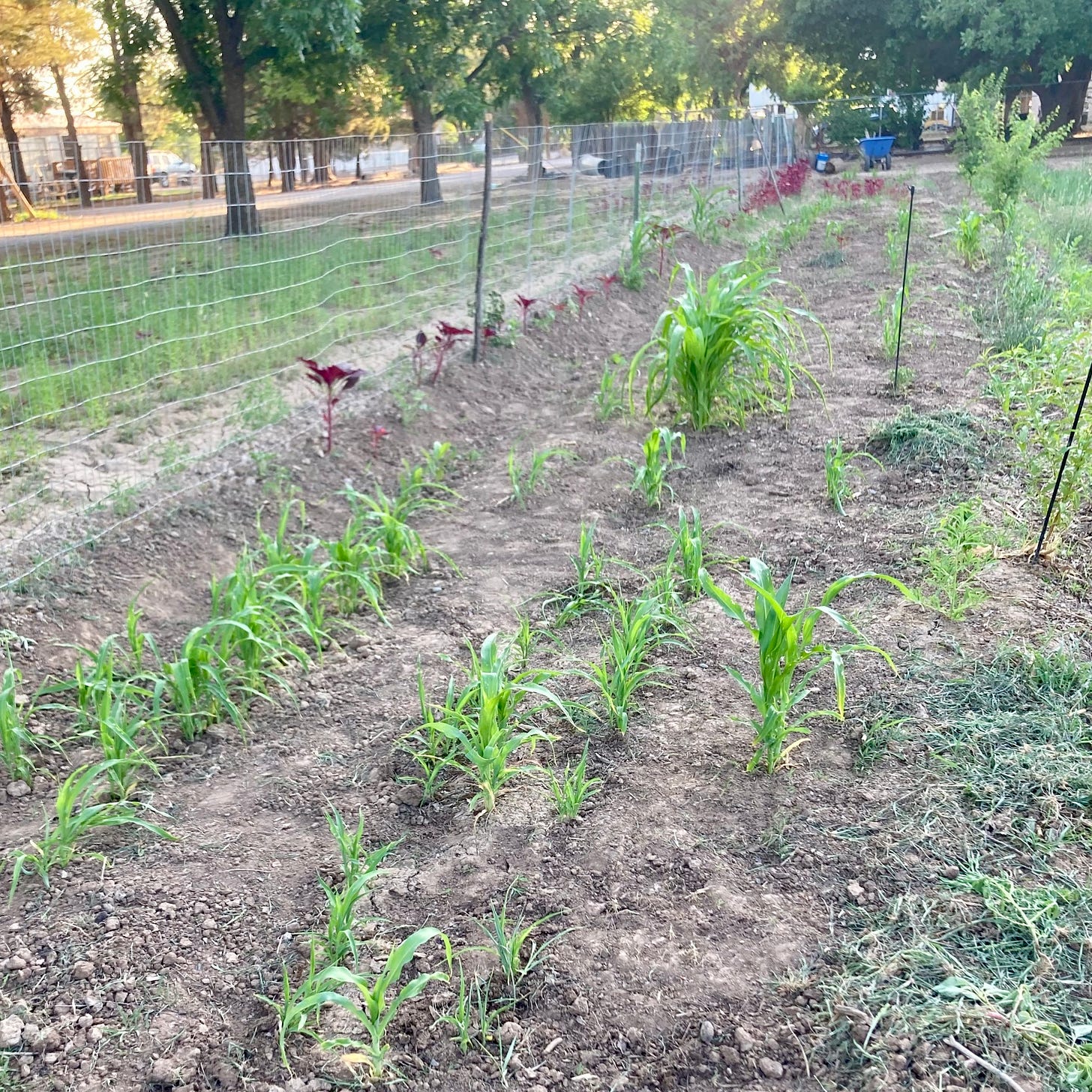I moved! I gave Denver an abrupt, jolly (kinda tipsy) goodbye to say “Hi again!” to Las Cruces, New Mexico.
Driving into the city just after sunset last Wednesday felt like traveling back in time. I haven’t lived here in nearly six years! Although the city limits are expanding, this place feels relatively static. I’ve changed a tremendous amount in the last six years, so the contrast between my evolution and Cruces’ is stark. I’m excited to use this time warp to become fully aware of the ways I’ve grown since leaving.
Not only does it feel like time has gone backwards in this last week of being home, but time also feels like it’s moving faster than usual. I think transitions and travel have a funny way of messing with timelines and our sense of them. I’m excited to use this time warp to grow with and in Las Cruces.
For the next six months I’m taking part in an agroecology program organized by Las Semillas: “Training Agroecological Farmers for a Hotter, Drier Future in the Chihuahuan Desert.” It’s the first iteration of a three-year project, so I consider myself lucky to be part of this inaugural cohort. It's an 11 person cohort, mostly made up of femmes of color. This gendered dynamic comes as no surprise; women and femmes always seem to be on the frontlines of taking care of our Earth and the climate. The gender makeup also gives it a really uplifting and cooperative energy as well. There’s several farm sites hosting us, all practicing some sort of small-scale, organic/sustainable agriculture. I’m working at Utopia Valley LLC with Anita Rodriguez.
My first day working at Utopia Valley felt like a true homecoming because I learned about Pecan trees. Anita led me in pruning her father’s trees’ branches and trimming the “suckers and sprouts” to encourage the tree to spend its energy in producing nuts. We examined the tree’s injuries, some from pests, others from the previous tractor weeding, which scraped their bark. Though I had been around pecan trees my whole life, I had never been around them quite like this. It felt intimate tending to them. It felt powerful connecting with these more-than-human beings and affirmed my intention for moving back--to develop a deeper connection with the land where I was born (and in turn, with myself).
Pecans are New Mexico’s leading cash crop, and second only to Georgia in nationwide production. Growing up, I'd see these giant, green trees everywhere. In this desert, the huge Salopek and Stahman pecan farms in Mesilla were the closest thing to an oasis. Pecan trees are beloved in Las Cruces. To farmers, they pay a nice nickel for relatively little labor (pruning, occasional watering, spraying and weeding). For those of us who aren’t farmers (landless), they’ve always been the perfect backdrop to picture perfect photos. You’ll always see people taking their graduation, engagement, or maternity photos on the side of old highway 28 under those enormous, lush canopies. I remember on one of my very first snow days I went sledding in a pecan orchard, so these trees hold a special place in my heart too. Pecan trees are more than just part of the landscape, they’re part of the collective memory and cultural fabric weaving my hometown together.
Pecans are thirsty thirsty crops though. When all of New Mexico is currently experiencing a severe drought, and climate change continues to go unchecked, I can’t help but worry about Las Cruces’ fate. Would I be able to recognize my hometown without Pecan trees? Would it even matter if there were no Pecan trees if there were no potable water left to drink? This experience has reminded me that Elephant Butte Irrigation District’s (EBID) water isn’t just for recreating and floating down the river; it’s our city’s literal survival.
If the pecan trees led me to realize and contemplate the tricky (colonized) situation my city is currently in, then planting three sisters gave me hope in our state’s agro-ecological future. On Sunday, I planted corn, squash, and beans all together for the first time. I helped seed Oaxacan black beans and a variety of squash (spaghetti, acorn, butternut) alongside some Zuni Blue Corn that had already come up. We followed a traditional Zuni (A:shiwi) Waffle Garden design.
The A:shiwi are native to the northwest of New Mexico, and are one of the largest pueblos in the state. Engaging in their agricultural legacy felt like a very intentional way to connect with the land I call home. I’ve read and heard about three sisters a bunch, but I had never actually had the opportunity to intentionally plant all three together. Every now and then a little maroon amaranth pop their leaves out between the baby corn stalks, splashing Anita’s property with color. I learned amaranth is not only an excellent plant to attract pollinators, but also a kind of “fourth sister” because they do really well with three sister gardens.
This past week we’ve also been racing to plant chile seeds, another classic New Mexico crash crop. It’s a little late in the season, but Anita soaked the seeds to encourage them to germinate faster. Oh, and weeding! Lots and lots of weeding. Anita uses zero chemicals (beyond organic), because she (and her mother, which is a story for another day) are wise women.
Aside from working at Utopia Valley, the program also involves “Agroecology as Movement” and “Agroecology as Practices” sessions, or a schedule of guest speakers and visits to the other sites. The first “Agroecology as Practice” session was a lecture from New Mexico State University Professor, Dr. Walker, an “extension vegetable specialist.” She chugged through over a hundred slides about planting vegetables: variety selection, irrigation, season extension, companion planting, intercropping and more. Dr. Walker’s lecture was jam-packed with useful information, which I look forward to reviewing and understanding in practice over the course of the next six months.
I learned that Dr. Walker is also a key player in patenting chili seeds at New Mexico State’s Chili Pepper Institute. I am not very educated on this issue, but I do remember attending a Vandana Shiva talk at Smith College in 2017 where she spoke on the matter and wholeheartedly disagreed with the claiming intellectual ownership of natural life processes. This talk I found on youtube is similar to the one I heard years ago and talks about what she calls “biopiracy”.
Later in the week we had an “Agroecology as Movement” session held at De Colores Farms’ where a brilliant member of our cohort, Natalia, asked about the implications of inviting such a professor to enter the community we are creating. “Is she aware?” Natalia asked. Her important question opened up a conversation about valorizing different forms of knowledge aside from those produced in established scientific institutions. It also reminded me of the role accountability plays in creating community.
After touring one of De Colores Farms sites, where farmer-mentor Ivonne grows alfalfa, corn, wheat, and a variety of vegetables, we helped her package wheat and corn for an order. We all worked together, playing music and eating creamy delicious turnip soup made by another one of our brilliant cohort members, Gia. This work session with all my peers reminded me of the word minga. I learned this word, which describes a kind of communal work party, while visiting rural communities in Peru. Knowledge of this South American vocabulary/practice helped me understand the magic of this borderland, women-led minga.
It’s good to be back, especially with a a fresh set of eyes.
In other news, I met a couple of incredibly kind, elder rastas (thanks craigslist!) who have been putting me on to all sorts of good tunes. Here’s some recommendations:
REGGAE:
Bob Marley The Heathen Live (notice Marley’s sick dance moves circa 3:00 min)
NOT REGGAE:
Bow Wow Wow - Do You Wanna Hold Me
Lastly, I’d like to recommend this
fucking excellent poem by Natalia Diaz:








